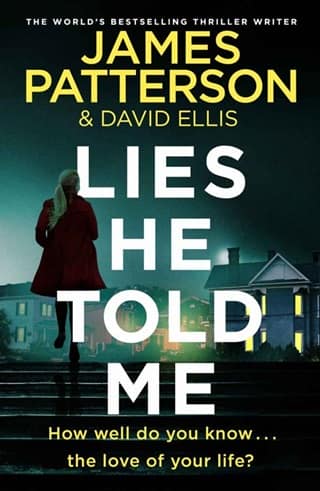FIFTY-FIVE
FIFTY-FIVE
"GRACE, I'M SORRY I snapped at you. Both of you, please clean out your lunch boxes. Lincoln, cello before dinner. Grace, piano."
I say this while gathering my bag from the car so the kids won't see my face directly, won't see the tears, won't notice the makeup smeared on my face.
The kids jump out of the car and head inside. They expect me to follow them. But I do not. Instead, I pull down the ceiling ladder and climb up into the attic above the garage.
Dark and creaky, a cold, open space, filled with Christmas decorations and old boxes. When I reach the top of the stairs, I find the switch to turn on the single lightbulb in the center of the space.
I walk carefully, navigating the haphazardly placed boxes, there being no need for order up here, every footstep producing a groan from the wooden floor. I veer around the boxes marked ORNAMENTS, step over the one marked WREATHS, angle past the faux Christmas tree.
In the far corner of the attic — personal records, placed in long plastic bins with lids, two rows, each stacked three high.
I separate them and spread them out on the floor. The lids identify the contents: GRACE AGES 0–3, LINCOLN AGES 0– 3 , and so on, all written in black Magic Marker on masking tape. There is one bin marked TAXES/FINANCES.
Since I married David, I have never done our taxes or scrutinized our finances. A box containing this information would be the last one he'd expect me to open.
I don't want to do this. I can't believe the path of my life has swerved in such a way that I need to do this. But I do.
I pry open the top of the bin. Inside are large legal-size envelopes, each fully stuffed, the tax year noted in Magic Marker.
I open the most recent one, pulling out nearly a hundred pages of documents and forms. W-2s and spreadsheets, estimated-payment vouchers, records of charitable contributions clipped together. Nothing. I stuff them back in the envelope.
I work in reverse chronological order, back to the previous year, then the year before that, finding the same sorts of documents, same results.
I comb through the rest of the envelopes and find one marked TAX YEAR 2008.
Years before I knew him. Again, probably the last envelope in this box that I would be expected to check.
I remove the contents. They are not tax forms.
First, inside a plastic sheath, are several copies of his birth certificate. A certificate of live birth, embossed with a seal. David Christopher Bowers, born in Chippewa County Hospital in Montevideo, Minnesota, mother Roberta Ann Bowers, father Edward Orleans Bowers.
A certificate from the Chippewa County Home for Boys, the orphanage where David lived for several years. A certificate of transfer to temporary care, signed by a guardian ad litem after David went to live with the first of several foster families.
All this fake, Kyle would say. The birth certificate, the orphanage certificate, the GAL transfer — none of it real, all of it doctored.
Next, two pages plucked from a photo album, three photos a page, stuffed in individual plastic pouches, three-hole punches on the side of each page.
The first page, photographs of three people at some celebratory event. Seemingly a mother, father, and son, posing for photos.
An older man in a suit and tie with gray curly hair, a roundness to his cheeks, a slight paunch at the midsection. An older woman, probably late forties or early fifties, light-complected with dark hair pulled back, wearing a long sparkly dress. In between them a younger man — a boy, really — maybe high school age or college, wearing a tie pulled down from the collar, his arms around the man and woman.
The young man would pass for a relative of David but not David himself. He is heavyset, with a wider nose, ears that protrude off his head, brown eyes instead of blue, and a mess of curly dark hair.
But David has no relatives. He is an only child, as were his mother and father. No siblings, aunts, or uncles.
I channel Kyle's voice: How convenient .
Okay, think harder. Looking at these photos, comparing them to David now: he could have lost weight, obviously, since this photo. And the curly hair? He's always shaved his head, ever since I knew him. He said it was because his hairline was receding and he liked the look of it shaved. Whatever. That's not the point right now.
The added weight and curly hair don't mean this boy isn't David. But the nose and protruding ears — those would require surgery.
But with surgery … yeah, maybe. This could be a childhood photo of David —
"No," I say quietly but firmly. No way. This is all crazy. I may not be able to recognize Silas Renfrow's face, but I would recognize his vibe . He was a ruthless killer. David couldn't have faked that away — not completely, not forever.
Have some faith in yourself, Marcie. You'd know the difference between a loving family man and a cold-blooded assassin.
Right?
I know who you are, the spray-painted note said. Am I missing the meaning?
The only other page: three more pictures of the same three people, but earlier in time. The boy younger, maybe eleven or twelve, in a baseball uniform holding a trophy, the mother and father beside him, hamming it up for the camera.
I breathe out a sigh. I'm getting nowhere. Nowhere except a train to insanity.
Then I notice, behind the two pages of photos, a manila envelope. Seemingly nothing inside. I shake it and hear a small rattle. Open it up.
Keys. Keys to safe-deposit boxes. Five in total.
Tiny cards attached to each by a string, bearing the typewritten words Prinell Bank followed by a number. Prinell Bank #323, Prinell Bank #324, and so on.
That's not our bank. I've never heard of that bank.
David has five safe-deposit boxes I don't know about.
 Fullepub
Fullepub 



